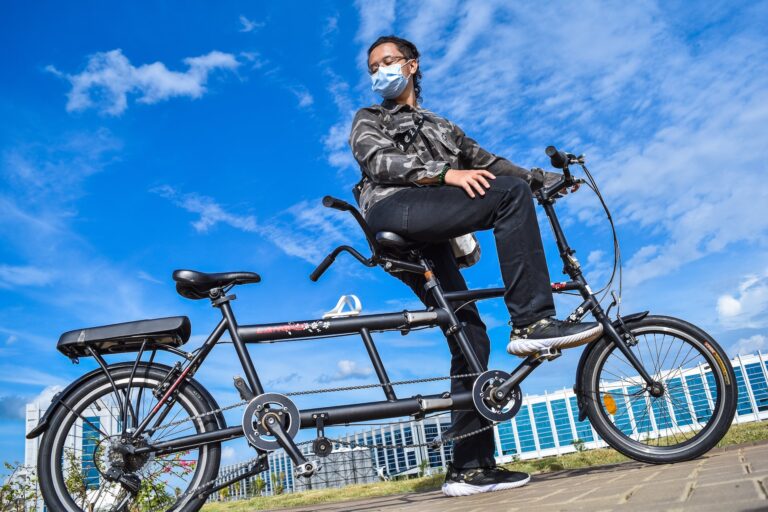When it comes to riding a tandem bike, there are several differences between a side-by-side and a tandem bike. One of the most important differences is the weight of each bike. If a tandem is heavy, the two riders will struggle to pedal at the same cadence. The lighter rider will achieve faster speeds when climbing a hill than a heavy rider.
Speed advantage
The speed advantage of tandems over side-by-sides is due in large part to the fact that they suffer less wind resistance than single bicycles. A tandem requires approximately 20% less power per rider than a single bicycle, owing to the stoker contributing minimal air resistance and drafting off the front cyclist.
A tandem is more stable and faster, particularly on descents. It also has fewer flat tires than a single bike. It also allows riders to ride together regardless of skill level. This type of bike is especially popular with couples, because both riders get a good workout. It is also great for pulling a trailer.
Weight advantage
The weight advantage of tandem bikes over side-by-sides is significant. The tandem can accommodate more weight and power, and it is easier to control two riders than one. A tandem is also more efficient for families, as two adults can cycle faster than one individual. Furthermore, two tandems use almost the same amount of energy to travel the same distance. This gives tandems a significant speed advantage, especially on downhills. A tandem can also be used effectively in flat areas and against headwinds.
Another weight advantage of tandems over side-by-sides is that they can carry more luggage. A tandem can hold four panniers, while a side-by-side can carry eight. This means that you can carry more luggage while traveling the same distance.
Aerodynamics
The aerodynamics of a tandem bike is different than that of a side-by-side. During an outdoor cycling event, a tandem cyclist may experience various types of atmospheric wind conditions. These conditions may affect the aerodynamics of the tandem cycle, and the optimal torso angle combination may not be applicable to all wind conditions. For example, crosswinds can affect the pilot’s drag distribution. A stoker’s drag increased by about eight seconds over a ten-kilometer time trial if the stoker leaned forward.
The advantage of a tandem over a side-by-side is that two riders share the weight. This allows them to pedal more effectively and more efficiently than they would on their own. The second advantage is that they can reach higher speeds than a single bike can. In addition, a tandem can go faster on steep hills.
Visibility
If you ride a tandem or side-by-side, you’re much more visible to drivers than a single cyclist. Due to their size and rarity, a tandem or side-by-side attracts the attention of drivers. This increased visibility decreases the risk of being hit by a car. It also makes you less prone to being attacked.
If you ride a tandem with your partner, you both have two sets of eyes on the road. You can each be watching for cars that are about to cut you off or other obstacles in the road. Your partner will also have two sets of eyes on the road to avoid those obstacles.
Starting technique
The starting technique for a tandem or side-by-side is much different than for a single bike. The stoker must apply smooth power while starting the bike, and the rider must keep their weight centred over the bicycle. The first start may be tricky, but with practice, the technique will become second nature.
The first step to learning the starting technique of a tandem or side-by-side is to get comfortable riding with the other rider. This involves balancing the weight of the front rider with the weight of the tandem bike. Then, the front rider should keep the bars still and smooth while counting down to standing up.
Frame strength
Frame strength is one of the first things you should consider before buying a tandem or side-by-side. Tandems and side-by-side have two riders, and the weight of the riders adds a lot of stress to the bike’s frame. You should know where the stress points are so you can properly build a strong frame. You can calculate the forces on the frame by drawing a simplified free-body diagram. This allows you to approximate the force at each node.
While most tandem and side-by-side frames are constructed of steel, there are some alloys that are stronger than others. For instance, Columbus uses a tool steel called NivaCrom. This steel contains small amounts of Niobium and Vanadium and is 30-40% stronger than traditional cromoly. This alloy also has the advantage of being safer because it requires a low-risk heat treatment process. NivaCrom is also available in 7/4/7 gauge. However, it is important to note that this alloy is only used by a few tandem and side-by-side manufacturers.
Physiological responses
Physiological responses between tandem and dual bicycle riders were compared in a study. The researchers found that the former exhibited less heart rate (HR) during pedaling than did the latter. At the same speed, the two bikes also experienced differences in the rate of lactic acid production. The findings of this study are relevant to recreational tandem cyclists.
One study found that the HR values of stokers were significantly lower when riding a tandem than when riding a single bicycle. However, the LA concentrations of the stokers were higher than those of the captains.






